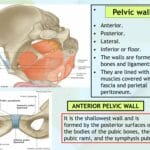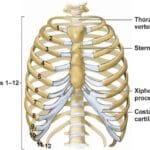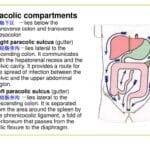The Ovarian Ligament: A Vital Link
The ovarian ligament, also known as the utero-ovarian ligament or proper ovarian ligament (ligamentum ovarii proprium), is a crucial fibrous band connecting the ovary to the uterus, playing a vital role in ovarian positioning and stability within the female pelvis. While often confused with the suspensory ligament of the ovary, the ovarian ligament has a distinct anatomical location and function, primarily anchoring the ovary to the uterus rather than the pelvic wall. Understanding the anatomy of the ovarian ligament is essential for comprehending various gynecological conditions, including ovarian torsion and the potential spread of ovarian cancer. Though small, the ovarian ligament plays a significant role in female reproductive health, contributing to proper ovarian function and overall pelvic stability.
Anatomy and Location
The ovarian ligament is a cord-like structure composed of fibrous and muscular tissue, providing both strength and flexibility. It resides within the broad ligament of the uterus, a sheet of peritoneum that acts as a supportive hammock for the uterus, ovaries, and fallopian tubes.
The ovarian ligament has specific attachment points:
- Ovary: Attaches to the uterine extremity (extremitas uterina) and the inferomedial aspect.
- Uterus: Attaches to the lateral angle of the uterine body (uterine horn) and the lateral surface.
- Proximity to Uterine Tubes: It’s also related to the posteroinferior aspect of the uterine tubes.
Function
This ligament’s primary function is to anchor the ovary to the uterus, ensuring its proximity to the fallopian tube for optimal egg transfer and fertilization. This anchoring also prevents the ovary from wandering within the pelvis, especially important during activities and pregnancy when internal organs shift. Beyond anchoring, the ligament acts as a conduit for blood vessels and nerves to supply the ovary with oxygen, nutrients, and enable communication with the rest of the body.
Clinical Significance
Several conditions can affect the ovarian ligament:
- Ovarian Masses/Cancers: Tumors or cancerous growths may stretch or distort the ligament.
- Ovarian Torsion: In this rare but serious condition, the ovary twists on its blood supply, sometimes involving the ovarian ligament. Some theories suggest that variations in the ligament’s length or elasticity could increase susceptibility, but research is ongoing. Are you experiencing sharp pains on your left rib cage? It could be a sign of a more serious condition, such as left rib pain icd 10. If you experience sudden chest pain radiating to your back, neck, jaw, or left arm, rule out a potential mediastinal shift, which can be life-threatening.
- Pelvic Pain: The ligament itself can become irritated or inflamed, causing chronic or intermittent pelvic pain, which can be challenging to diagnose. Current research is exploring contributing factors, including hormonal changes and previous infections.
Development
The ovarian ligament originates from the gubernaculum during fetal development. This structure guides the descent of the ovaries from the abdomen to the pelvis. As the ovaries reach their final position, the gubernaculum transforms into several ligaments, including the ovarian ligament. This complex process is still being actively studied.
What is the Ovarian Ligament of the Ovary? (Ligamentum Ovarii Proprium)
This section is redundant and has been incorporated into the main section above.
What are the Ligaments of the Parametrium? (Ligamentum Ovarii Proprium)
Understanding the Parametrium and Its Ligaments
The parametrium, connective tissue adjacent to the uterus within the pelvic cavity, serves as a critical support system and pathway for blood vessels and nerves. Key ligaments within or closely associated with the parametrium include:
- Utero-Ovarian Ligament (Proper Ovarian Ligament):
- This fibrous and muscular ligament connects the ovary directly to the uterus, providing crucial stability and residing within the broad ligament.
- Broad Ligament:
- This peritoneal fold envelops the uterus, fallopian tubes, and ovaries. While not solely within the parametrium, portions contribute to its structure and function, acting as a conduit for blood vessels and nerves.
- Suspensory Ligament of the Ovary:
- While not strictly within the parametrium, this ligament carries ovarian vessels and nerves, extending from the ovary to the abdominal wall. It is often considered an extension of the broad ligament.
- Round Ligaments of the Uterus:
- These ligaments provide added uterine support and contribute to the overall stability of the region, though they are not directly part of the parametrium.
Understanding these ligaments is crucial for comprehending female reproductive health and addressing related medical issues. Issues like stretching due to ovarian masses can have significant clinical implications.
What are the Peritoneal Ligaments of the Ovary? (Ligamentum Ovarii Proprium)
Peritoneal Ligaments: Supporting and Supplying the Ovaries
The ovaries are secured and nourished by two main peritoneal ligaments:
- Suspensory Ligament of the Ovary:
- This peritoneal fold extends from the mesovarium to the pelvic wall, acting as a lifeline, carrying the ovarian artery, vein, nerves, and lymphatic vessels. It’s often considered part of the broad ligament.
- Ovarian Ligament (Utero-Ovarian Ligament/Proper Ovarian Ligament):
- This fibrous ligament, composed of muscular and fibrous tissue, connects the ovary directly to the uterus, providing stability and residing within the broad ligament.
These ligaments, along with the mesovarium (a peritoneal fold attaching the ovary to the broad ligament) and the broad ligament itself, ensure proper ovarian positioning for reproductive processes. While generally reliable, issues like ovarian torsion, where the ovary twists around the ligament, cutting off its blood supply, can occur. Ongoing research explores the ligaments’ composition, development, structural variations, and potential impact on fertility and conditions like endometriosis and pelvic pain.
| Ligament | Function | Connection |
|---|---|---|
| Suspensory Ligament | Supports ovary, carries blood vessels, nerves, lymphatics | Ovary to Pelvic Wall |
| Ovarian Ligament (Utero-ovarian) | Connects ovary to uterus, provides stability, carries nerves and blood vessels | Ovary to Uterus |
This information aims to provide a better understanding of the peritoneal ligaments and their role in ovarian health. Remember that medical research is constantly evolving, and consulting with a healthcare professional is crucial for addressing individual health concerns.
- Discover Famous Doctors: Groundbreaking Advances in Medicine - April 11, 2025
- What Ended the Long Drives?Ranching’s Transformation - April 11, 2025
- How Are Islands Formed: A Comprehensive Guide to Island Genesis - April 11, 2025
















2 thoughts on “Understanding the Ligamentum Ovarii Proprium: Anatomy, Function, and Clinical Significance”
Comments are closed.